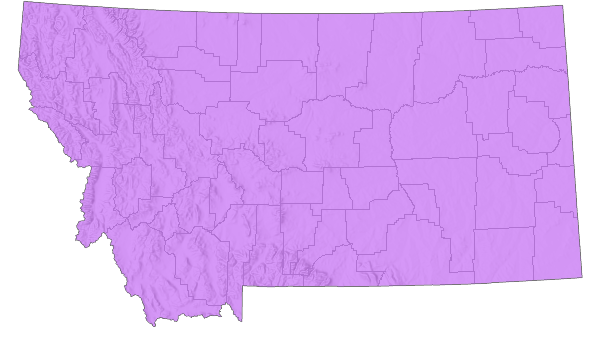View in other NatureServe Network Field Guides
NatureServe
Montana
Utah
Wyoming
Idaho
Wisconsin
British Columbia
South Carolina
Yukon
California
New York
Crawe's Sedge - Carex crawei
State Rank Reason (see State Rank above)
Rare in Montana, where it is known from several areas. A few sites contain moderate to large populations. Trend data are lacking for the species. Negative impacts to populations from hydrologic changes are a potential threat.
General Description
Rhizomatous. Stems erect, 5–20 cm. Leaves basal and cauline; blades 1–4 mm wide. Inflorescence of 2 to 5 well-separated spikes; the lowest bract shorter than the inflorescence. Spikes ascending; the uppermost male, 1–2 cm long; the lower female, 8–20 mm long, pedunculate, sometimes arising from the base. Perigynia spreading to ascending, green to tan, glabrous, ovoid, 2.5–3.5 mm long with an obscure beak; stigmas 3. Female scales ovate, tan with pale margins and a green midvein, shorter and narrower then the perigynia. Achene 3-sided, partly filling the perigynium (
Lesica et al. 2012. Manual of Montana Vascular Plants. BRIT Press. Fort Worth, TX).
Phenology
The fruit matures in July.
Diagnostic Characteristics
Carex is a large genus in Montana; the following collection of characters separate Crawe's sedge from others in the state. Crawe's sedge has 3-sided achenes and a slender, terminal male spike less than 20 mm long. It has erect, rather than spreading or drooping, female spikes, and the glabrous, yellow-green perigynia do not have distinct beaks. Of the similar species, Carex livida has whitish perigynia and always grows in peat, and both Carex lanuginosa and C. lasiocarpa have hairy perigynia.
Species Range
Montana Range
Range Descriptions

 Native
Native
Range Comments
BC to NL south to WA, UT, WY, OK, AL and GA (Lesica et al. 2012. Manual of Montana Vascular Plants. BRIT Press. Fort Worth, TX).
Observations in Montana Natural Heritage Program Database
Number of Observations: 20
(Click on the following maps and charts to see full sized version)
Map Help and Descriptions
Relative Density

Recency



 (Observations spanning multiple months or years are excluded from time charts)
(Observations spanning multiple months or years are excluded from time charts)
Habitat
Crawe's sedge grows in wet, gravelly or sandy soil along streams or pond margins, often where there is some natural wave or flow disturbance. It occurs in the valleys and montane foothills, especially where the dominant parent material is calcareous. Common associates include Carex oederi, C. lanuginosa, C. aurea, Juncus balticus, and Potentilla fruticosa.
Ecology
Crawe's sedge often occupies early successional, riparian habitats that may require flooding to prevent development of soil and vegetation.
Management
This species' response to livestock grazing or trampling is unknown. Crawe's sedge may be vulnerable to alterations in natural disturbance regimes or hydrology as well as developments, such as road construction, that tend to occur in valley bottoms.
Stewardship Responsibility
Threats or Limiting Factors
STATE THREAT SCORE REASON
Reported threats to Montana's populations of Crawe’s Sedge are impacts to a roadside population. Direct damage to plants or the population by construction and maintenance activities, or indirect impacts characteristic of transportation corridors are potential risks (MTNHP Threat Assessment 2021).
References
- Literature Cited AboveLegend:
 View Online Publication
View Online Publication Lesica, P., M.T. Lavin, and P.F. Stickney. 2012. Manual of Montana Vascular Plants. Fort Worth, TX: BRIT Press. viii + 771 p.
Lesica, P., M.T. Lavin, and P.F. Stickney. 2012. Manual of Montana Vascular Plants. Fort Worth, TX: BRIT Press. viii + 771 p. MTNHP Threat Assessment. 2021. State Threat Score Assignment and Assessment of Reported Threats from 2006 to 2021 for State-listed Vascular Plants. Botany Program, Montana Natural Heritage Program, Helena, Montana.
MTNHP Threat Assessment. 2021. State Threat Score Assignment and Assessment of Reported Threats from 2006 to 2021 for State-listed Vascular Plants. Botany Program, Montana Natural Heritage Program, Helena, Montana.
- Additional ReferencesLegend:
 View Online Publication
View Online Publication
Do you know of a citation we're missing? Heidel, B.L. 1994. Survey for Psoralea hypogaea in the Great Falls Resource Area, Lewistown District. Unpublished report to the Bureau of Land Management, Montana. Montana Natural Heritage Program, Helena, Montana. 22 pp. plus appendices.
Heidel, B.L. 1994. Survey for Psoralea hypogaea in the Great Falls Resource Area, Lewistown District. Unpublished report to the Bureau of Land Management, Montana. Montana Natural Heritage Program, Helena, Montana. 22 pp. plus appendices. Hermann, F. J. 1970. Manual of the Carices of the Rocky Mountains and Colorado Basin. Agricultural Handbook No. 374. USDA Forest Service. 397 pp.
Hermann, F. J. 1970. Manual of the Carices of the Rocky Mountains and Colorado Basin. Agricultural Handbook No. 374. USDA Forest Service. 397 pp. Lesica, P. 1991. The Rare Vascular Plants of Pine Butte Swamp Preserve. Unpublished Report to the Nature Conservancy. 15 Pp.
Lesica, P. 1991. The Rare Vascular Plants of Pine Butte Swamp Preserve. Unpublished Report to the Nature Conservancy. 15 Pp. Lesica, P. and J. S. Shelly. 1988. The vegetation and flora of glaciated prairie potholes on the Blackfeet Indian Reservation, Montana: Progress report. Unpublished report to the Montana Nature Conservancy, Helena, MT. 19 pp.
Lesica, P. and J. S. Shelly. 1988. The vegetation and flora of glaciated prairie potholes on the Blackfeet Indian Reservation, Montana: Progress report. Unpublished report to the Montana Nature Conservancy, Helena, MT. 19 pp. Lesica, P., M.T. Lavin, and P.F. Stickney. 2022. Manual of Montana Vascular Plants, Second Edition. Fort Worth, TX: BRIT Press. viii + 779 p.
Lesica, P., M.T. Lavin, and P.F. Stickney. 2022. Manual of Montana Vascular Plants, Second Edition. Fort Worth, TX: BRIT Press. viii + 779 p.
- Web Search Engines for Articles on "Crawe's Sedge"





